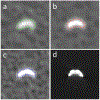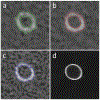Improved coronary calcification quantification using photon-counting-detector CT: an ex vivo study in cadaveric specimens
- PMID: 33713174
- PMCID: PMC8380662
- DOI: 10.1007/s00330-021-07780-6
Improved coronary calcification quantification using photon-counting-detector CT: an ex vivo study in cadaveric specimens
Abstract
Objectives: To compare the accuracy of coronary calcium quantification of cadaveric specimens imaged from a photon-counting detector (PCD)-CT and an energy-integrating detector (EID)-CT.
Methods: Excised coronary specimens were scanned on a PCD-CT scanner, using both the PCD and EID subsystems. The scanning and reconstruction parameters for EID-CT and PCD-CT were matched: 120 kV, 9.3-9.4 mGy CTDIvol, and a quantitative kernel (D50). PCD-CT images were also reconstructed using a sharper kernel (D60). Scanning the same specimens using micro-CT served as a reference standard for calcified volumes. Calcifications were segmented with a half-maximum thresholding technique. Segmented calcified volume differences were analyzed using the Friedman test and post hoc pairwise Wilcoxon signed rank test with the Bonferroni correction. Image noise measurements were compared between EID-CT and PCD-CT with a repeated-measures ANOVA test and post hoc pairwise comparison with the Bonferroni correction. A p < 0.05 was considered statistically significant.
Results: The volume measurements in 12/13 calcifications followed a similar trend: EID-D50 > PCD-D50 > PCD-D60 > micro-CT. The median calcified volumes in EID-D50, PCD-D50, PCD-D60, and micro-CT were 22.1 (IQR 10.2-64.8), 21.0 (IQR 9.0-56.5), 18.2 (IQR 8.3-49.3), and 14.6 (IQR 5.1-42.4) mm3, respectively (p < 0.05 for all pairwise comparisons). The average image noise in EID-D50, PCD-D50, and PCD-D60 was 60.4 (± 3.5), 56.0 (± 4.2), and 113.6 (± 8.5) HU, respectively (p < 0.01 for all pairwise comparisons).
Conclusion: The PCT-CT system quantified coronary calcifications more accurately than EID-CT, and a sharp PCD-CT kernel further improved the accuracy. The PCD-CT images exhibited lower noise than the EID-CT images.
Key points: • High spatial resolution offered by PCD-CT reduces partial volume averaging and consequently leads to better morphological depiction of coronary calcifications. • Improved quantitative accuracy for coronary calcification volumes could be achieved using high-resolution PCD-CT compared to conventional EID-CT. • PCD-CT images exhibit lower image noise than conventional EID-CT at matched radiation dose and reconstruction kernel.
Keywords: Artifacts; Cadaver; Coronary artery disease; X-ray tomography.
© 2021. European Society of Radiology.
Figures






Similar articles
-
Dose Reduction for Sinus and Temporal Bone Imaging Using Photon-Counting Detector CT With an Additional Tin Filter.Invest Radiol. 2020 Feb;55(2):91-100. doi: 10.1097/RLI.0000000000000614. Invest Radiol. 2020. PMID: 31770297 Free PMC article.
-
Quantification of Coronary Calcification using High-Resolution Photon-Counting-Detector CT and an Image Domain Denoising Algorithm.Proc SPIE Int Soc Opt Eng. 2022 Feb-Mar;12031:120311R. doi: 10.1117/12.2612999. Epub 2022 Apr 4. Proc SPIE Int Soc Opt Eng. 2022. PMID: 35677470 Free PMC article.
-
Ex vivo coronary calcium volume quantification using a high-spatial-resolution clinical photon-counting-detector computed tomography.J Med Imaging (Bellingham). 2023 Jul;10(4):043501. doi: 10.1117/1.JMI.10.4.043501. Epub 2023 Jul 4. J Med Imaging (Bellingham). 2023. PMID: 37408984 Free PMC article.
-
An introduction to photon-counting detector CT (PCD CT) for radiologists.Jpn J Radiol. 2023 Mar;41(3):266-282. doi: 10.1007/s11604-022-01350-6. Epub 2022 Oct 18. Jpn J Radiol. 2023. PMID: 36255601 Free PMC article. Review.
-
Clinical applications of photon counting detector CT.Eur Radiol. 2023 Aug;33(8):5309-5320. doi: 10.1007/s00330-023-09596-y. Epub 2023 Apr 5. Eur Radiol. 2023. PMID: 37020069 Free PMC article. Review.
Cited by
-
Implications of coronary calcification on the assessment of plaque pathology: a comparison of computed tomography and multimodality intravascular imaging.Eur Radiol. 2025 Apr;35(4):1745-1760. doi: 10.1007/s00330-024-10996-x. Epub 2024 Aug 22. Eur Radiol. 2025. PMID: 39172246 Free PMC article.
-
Measurement of enhanced vasa vasorum density in a porcine carotid model using photon counting detector CT.J Med Imaging (Bellingham). 2023 Jan;10(1):016001. doi: 10.1117/1.JMI.10.1.016001. Epub 2023 Feb 6. J Med Imaging (Bellingham). 2023. PMID: 36778671 Free PMC article.
-
Coronary Artery Calcification: Current Concepts and Clinical Implications.Circulation. 2024 Jan 16;149(3):251-266. doi: 10.1161/CIRCULATIONAHA.123.065657. Epub 2024 Jan 16. Circulation. 2024. PMID: 38227718 Free PMC article. Review.
-
Radiation dose optimization for photon-counting CT coronary artery calcium scoring for different patient sizes: a dynamic phantom study.Eur Radiol. 2023 Jul;33(7):4668-4675. doi: 10.1007/s00330-023-09434-1. Epub 2023 Feb 2. Eur Radiol. 2023. PMID: 36729174 Free PMC article.
-
Photon-Counting Computed Tomography (PCCT): Technical Background and Cardio-Vascular Applications.Diagnostics (Basel). 2023 Feb 9;13(4):645. doi: 10.3390/diagnostics13040645. Diagnostics (Basel). 2023. PMID: 36832139 Free PMC article. Review.
References
-
- Global Health Estimates (2016) Deaths by cause, age, sex, by country and by region, 2000–2016. World Health Organization, Geneva
-
- Sangiorgi G, Rumberger JA, Severson A et al. (1998) Arterial calcification and not lumen stenosis is highly correlated with atherosclerotic plaque burden in humans: a histologic study of 723 coronary artery segments using nondecalcifying methodology. J Am Coll Cardiol 31:126–133 - PubMed
-
- Rumberger JA, Simons DB, Fitzpatrick LA, Sheedy PF, Schwartz RS (1995) Coronary artery calcium area by electron-beam computed tomography and coronary atherosclerotic plaque area. A histopathologic correlative study. Circulation 92:2157–2162 - PubMed
-
- Detrano R, Guerci AD, Carr JJ et al. (2008) Coronary calcium as a predictor of coronary events in four racial or ethnic groups. N Engl J Med 358:1336–1345 - PubMed
MeSH terms
Grants and funding
LinkOut - more resources
Full Text Sources
Other Literature Sources
Medical

